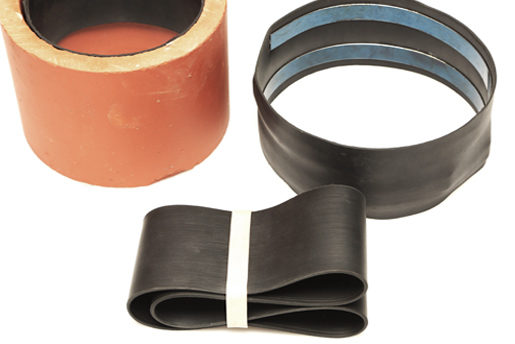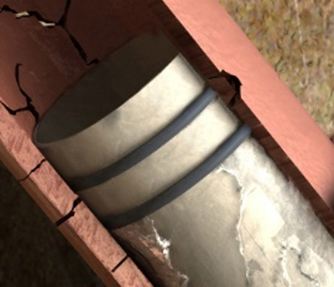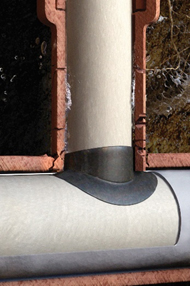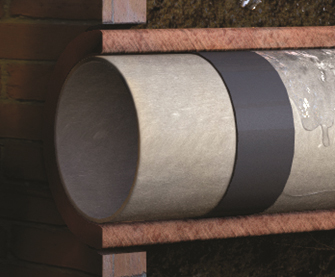Insignia End Seal Sleeve
- Home
- /Insignia End Seal Sleeve


Gasket Sealing
The Insignia™ End Seal Sleeve is a seamlessly molded end seal that provides a large sealing surface guaranteeing a uniform water-tight seal. The sleeve provides the following advantages over other less precise hydrophilic sealing systems.
- 360 Degree Swelling Gasket The Insignia™ End Seal Sleeve is a seamless molded seal with no joints or weak points preventing any damage or inefficient sealing of the annular space between the liner and the host pipe.
- Retaining Rings The Insignia™ End Seal Sleeve includes a retaining ring that is placed on the leading end of the liner. This ring holds the end seal in place and ensures no movement is allowed during CIPP rehabilitation.
- Significant Surface Area The gasket allows for more swelling than less precise methods of sealing such as hydrophilic tape. The end seal is able to absorb more water and seal the annular space efficiently because of its larger surface area.
- Compatible With Multiple Types of CIPP The Insignia™ End Seal Sleeve is a versatile hydrophilic sealing system compatible with all types of CIPP liners, including inversion and pull-in-place liners. The End Seal Sleeve will swell in the presence of water regardless on the type of host pipe.
Insignia™ End Seal Sleeve
ASTM F3240



Significance and Use
Purchase the full version of this standard by visiting the ASTM website here.
This practice is for use by designers and specifiers, regulatory agencies, owners, and inspection organizations that are involved in the rehabilitation of main and lateral pipelines and manholes. As for any practice, modifications may be required for specific job conditions.
1. Scope
- This practice covers the requirements for the installation of seamless molded hydrophilic gaskets (SMHG) in cured in place pipe (CIPP) rehabilitation of main and lateral pipelines.
- The values stated in inch-pound units are to be regarded as standard. The values given in parentheses are mathematical conversions to SI units that are provided for information only and are not considered standard.
- There is no similar or equivalent ISO Standard.
- This standard does not purport to address all of the safety concerns, if any, associated with its use. It is the responsibility of the user of this standard to establish appropriate safety, health, and environmental practices and determine the applicability of regulatory limitations prior to use.
- This international standard was developed in accordance with internationally recognized principles on standardization established in the Decision on Principles for the Development of International Standards, Guides and Recommendations issued by the World Trade Organization Technical Barriers to Trade (TBT) Committee.
2. Referenced Documents
2.1 ASTM Standards:
- D1149 Test Methods for Rubber Deterioration-Cracking in an Ozone Controlled Environment
- D1600 Terminology for Abbreviated Terms Relating to Plastics
- D2240 Test Method for Rubber Property-Durometer Hardness
- F412 Terminology Relating to Plastic Piping Systems
- F1216 Practice for Rehabilitation of Existing Pipelines and Conduits by the Inversion and Curing of a Resin-Impregnated Tube
- F1743 Practice for Rehabilitation of Existing Pipelines and Conduits by Pulled-in-Place Installation of Cured-in-Place Thermosetting Resin Pipe (CIPP)
- F2019 Practice for Rehabilitation of Existing Pipelines and Conduits by the Pulled in Place Installation of Glass Reinforced Plastic (GRP) Cured-in-Place Thermosetting Resin Pipe (CIPP)
- F2599 Practice for The Sectional Repair of Damaged Pipe By Means of An Inverted Cured-In-Place Liner
- F2561 Practice for Rehabilitation of a Sewer Service Lateral and Its Connection to the Main Using a One Piece Main and Lateral Cured-in-Place Liner
2.2 NASSCO Guidelines:
Recommended Specifications for Sewer Collection System Rehabilitation
- PACP NASSCO Pipeline Assessment & Certification Program
2.3 ISO Standard
- ISO 17025 General requirements for the competence of testing and calibration laboratories
2.3 ISO Standard
anchor screws; CIPP; connection seal; cured in place liner; end seal sleeve; leading edge; mechanical fastener; O -Ring; seamless molded hydrophilic gasket (SMHG); sectional liner; watertight seal

